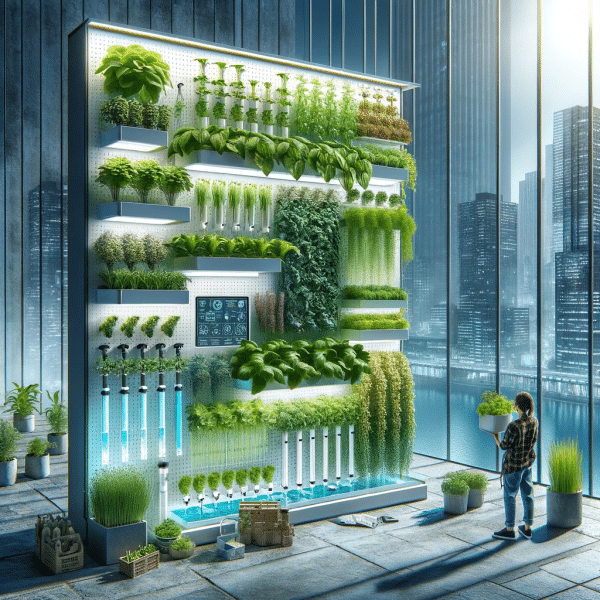
Maximizing Sustainability: How Hydroponic Vertical Gardens Reduce Your Carbon Footprint
Imagine a world where your daily actions don't just make your life better but also make the Earth a greener, healthier place for future generations. That's the world we can create, and it starts right in your backyard or on your balcony. Welcome to the world of hydroponic vertical gardens, where sustainability meets self-sufficiency, and your carbon footprint takes a much-needed step back.
So, what exactly is this revolutionary gardening technique that's got everyone talking? Hydroponic vertical gardening is like traditional gardening, but with a futuristic twist. Instead of soil, plants are grown in nutrient-rich water solutions, and they're stacked vertically, optimizing space and resources.
But why should you care about hydroponic vertical gardening? Let's talk about the elephant in the room: your carbon footprint. It's that invisible mark we all leave on the environment, a result of our daily activities, from driving to work to the food we consume. And it's a big problem. The Earth can only handle so much before it starts to show signs of wear and tear, like climate change and resource depletion.
Now, here's where hydroponic vertical gardens come into play. They're like superheroes in the world of sustainability. By embracing this innovative approach to gardening, you can significantly reduce your carbon footprint without sacrificing the joy of growing your own food.
Traditional agriculture often involves large plots of land, extensive use of water, and transportation of produce across long distances. This leads to carbon emissions, water wastage, and a strain on our ecosystems. Hydroponic vertical gardens, on the other hand, use space efficiently, require less water, and cut down on transportation needs.
Imagine it this way: If traditional gardening is like a gas-guzzling SUV, hydroponic vertical gardening is the sleek electric car of the gardening world. It's eco-friendly, efficient, and it'll save you money in the long run. Plus, it lets you take control of your food production, which is not just empowering but also incredibly satisfying.
Benefits of Hydroponic Vertical Gardens
Now that you've dipped your toes into the world of hydroponic vertical gardening, it's time to explore the incredible benefits that await you. These gardens are not just a trend; they're a game-changer in the quest for a sustainable and self-sufficient lifestyle.
1. Efficient Resource Utilization: Picture a traditional garden, sprawling over your backyard, thirsty for gallons of water. In contrast, hydroponic vertical gardens are like water-sipping connoisseurs. They use up to 90% less water, thanks to their recirculating systems that recycle and reuse this precious resource. It's not just eco-friendly; it's wallet-friendly too.
2. Minimal Pesticide and Herbicide Use: Worried about harmful chemicals in your food? Hydroponic vertical gardens reduce the need for pesticides and herbicides. With precise control over the growing environment, you can say goodbye to harmful chemicals and hello to pure, pesticide-free produce.
3. Reduced Transportation Emissions: Ever wondered how far your groceries travel to reach your plate? Hydroponic vertical gardens bring your food source closer to home. By growing your own greens, you cut down on transportation emissions, reducing your carbon footprint one leaf at a time.
4. Year-Round Food Production: Traditional gardens have their limits, especially in colder climates. But with hydroponic vertical gardening, the seasons no longer dictate when you can enjoy fresh, homegrown produce. You can harvest your favorite veggies year-round, even in the dead of winter.
So, think of hydroponic vertical gardens as the superheroes of sustainability. They save resources, protect your health, and fight climate change without requiring a cape.
Real-Life Success Stories
Now that you've seen the remarkable benefits of hydroponic vertical gardens, let's step into the real world and discover how individuals just like you are turning these benefits into reality.
Meet Jane, a city dweller with a passion for sustainable living. She transformed her tiny apartment balcony into a thriving vertical garden oasis. With minimal space and a little creativity, she now grows her own herbs, vegetables, and even some fruits. Jane's carbon footprint has shrunk, and her connection to her food source has deepened.
And then there's Mark, a father of two who wanted to teach his kids the importance of self-sufficiency and environmental responsibility. He installed a hydroponic vertical garden in their backyard. Together, they've watched their plants flourish, and Mark's children have developed a newfound appreciation for where their food comes from.
These stories are just the tip of the iceberg. People from all walks of life are embracing hydroponic vertical gardening, not only for the tangible benefits it offers but also for the sense of fulfillment and connection it provides. It's a way to be part of the solution, to reduce your carbon footprint, and to nurture your self-sufficiency.
So, as you've journeyed through this article, you've glimpsed into a world where hydroponic vertical gardens are changing lives and reducing carbon footprints. They're more than just gardens; they're agents of positive change.
In conclusion, whether you're an urbanite with limited space or a suburbanite with a green backyard, hydroponic vertical gardening has something to offer. It's a sustainable, self-sufficient choice that not only benefits you but also the planet we all call home.
As you embark on your own hydroponic vertical gardening adventure, remember that every leaf you grow is a step towards a greener, healthier future. So, get your hands dirty, nurture your garden, and watch your carbon footprint shrink as you maximize sustainability.
Ready to start your journey? Dive in and grow the change you want to see!
